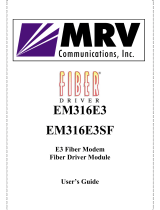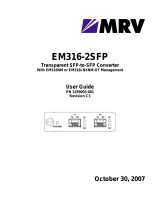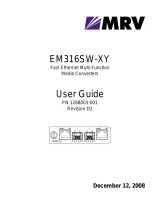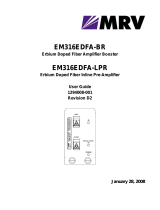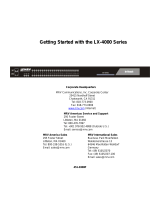Page is loading ...

EM316T1
EM316E1
Fiber Driver Modem
User’s Guide

Fiber Driver
EM316E1/EM316T1
P/N: 1218003-001, REV_O PAGE 2
Registration Card
Your name: Mr./Ms___________________________________________
Organization: ________________________Dept. __________________
Your title at organization:______________________________________
Telephone: ___________________________ Fax:__________________
Organization's full address:____________________________________
__________________________________________________________
Country:___________________________________________________
Date of purchase (Month/Day/Year):_____________________________
Serial number:
Product was purchased from:
Reseller's name:____________________________________________
Telephone:___ __________________ Fax:_______________________
Reseller's
full address___________________________________________________
___________________________________________________
Answers to the following questions help us to support your product:
1. Where and how will the product primarily be used?
Home Office Travel Company Business Home Business Personal Use
2. How many employees work at installation site?
1 employee 2-9 10-49 50-99 100-499 500-999 1000+
3. What network medium/media does your organization use ?
Fiber-optics Thick coax Ethernet Thin coax Ethernet
10BASE-T UTP/STP 100BASE-TX 100BASE-T4 100VGAnyLAN
Others_________________
4. What category best describes your company?
Aerospace Engineering Education Finance Hospital
Legal Insurance/Real Estate Manufacturing
Retail/Chain store/Wholesale Government
Transportation/Utilities/Communication VAR System house/company
Other________________________________
5. Would you recommend your Fiber Driver product to a friend?
Yes No Don't know yet

Fiber Driver
EM316E1/EM316T1
P/N: 1218003-001, REV_O PAGE 3
EM316E1
EM316T1
Fiber Driver Modem
User’s Guide

Fiber Driver
EM316E1/EM316T1
P/N: 1218003-001, REV_O PAGE 4
TABLE OF CONTENTS
1 INTRODUCTION
2 HARDWARE INSTALLATION
3 TROUBLESHOOTING
4 TECHNICAL SPECIFICATIONS
5 CONTACT INFORMATION
6 GLOSSARY
7 ORDERING INFORMATION

Fiber Driver
EM316E1/EM316T1
P/N: 1218003-001, REV_O PAGE 5
1 INTRODUCTION
About this Manual
Before unpacking please refer to section 2 (Hardware Installation)
This manual is a guide to the installation and operation of the EM316E1/T1 Fiber
Modem.
Product description describes the product, its functions, features, protocol supported,
minimum requirements, and typical applications.
Installation guides you through the setup of the EM316E1/T1 to your network.
Customer support provides information on return policy and customer support
information.
Glossary provides definition to terms used in this manual.
Product Description
The EM316T1 and the EM316E1 modules of the Fiber Driver Family are Fiber Modems
designed to extend the distance and transmission reliability of T1 (1.544Mbps) or E1
(2.048Mbps) traffic. These units convert the electrical signals to optical signals and
transmit them over distances of up to 4km on multimode fiber, or distances of up to
100km on singlemode fiber. The EM316T1 and EM316E1 are transparent to the framing
format, and support AMI or B8ZS (T1) and HDB3 (E1) line codes respectively. They
include an internal elastic buffer to remove jitter from transmit data. Six LED indicators
help monitoring and trouble-shooting, and a management agent is incorporated on the
module to enable remote in-band and out-of-band control and management in
conjunction with the Fiber Driver SNMP management card.
The EM316E1/T1 single fiber modules use unique technology that provides the ability to
combine TX and RX signals onto a single fiber strand. This effectively doubles the
available fiber in a network and eliminates the need for additional fiber connections. An
identical unit is required on the other end, using either standard APC (Angled PC) patch
cords finish or a 3M VAR APC finish. The standard APC finish provides a <-60dB back
reflection, whereas the 3M VAR exceeds –70dB. Both APC finishes are polished to an
8
o
angle and minimize back reflection by forcing the reflected rays into the cladding.
The Fiber Driver family provides conversion solutions with greater distances and better
manageability than any other products on the market. Multimode to Singlemode fiber
conversion modules offers link distances from 0 km to 100 km.

Fiber Driver
EM316E1/EM316T1
P/N: 1218003-001, REV_O PAGE 6
Features
• Modules can be Inserted / Removed without powering off the chassis
•
Extensive Network Management Support when used with EM316NM
•
Provide Fiber Link for T1(ANSI T1.403) or E1 (G.703) Applications
•
Built-in Elastic Buffer to Remove Jitter
•
LED Indicators to help Trouble-Shooting
•
Support AMI/B8ZS/HDB3 Line Codes
•
Up to 100km Transmission on Singlemode or 4km on Multimode Fiber
•
AC 110-220 volts or -48 DC power
•
Supports Local & Remote Loopback Test
*For dB budget see: ftp://ftp.fiberdriver.com/pub/doc/spec/fiberdriver
Requirements for Managed Module
EM316NM Management Firmware version 3.43 or later
For firmware released version go to:
ftp://ftp.fiberdriver.com/pub/software/em316nm
For firmware beta version go to:
ftp://ftp.fiberdriver.com/pub/software/beta/em316nm
MegaVision Network Management version 1.17 or later

Fiber Driver
EM316E1/EM316T1
P/N: 1218003-001, REV_O PAGE 7
Connectivity
Connectors Used
Fiber: ST, or SC-APC (for single fiber)
UTP: RJ48-MDI
Coax: BNC (2 connectors: 1 for TX, 1 for RX)
Cable Requirement
Fiber: ST-ST fiber cable, or SC-APC fiber cable (for single fiber)
UTP: Category 5
Coax: RG58/U
Port Description
Input: E1 (BNC) or T1 (UTP-RJ48)
Output: Fiber Modem, Multi-Mode: 1310nm, 0-2km
Single Mode: 1310nm, 0-25km
Single Mode: 1310nm, 25-50km
Single Mode: 1550nm, 50-100km
Connector Pin-out
Female RJ-48 (MDI)
1 RRING 5 TTIP
2 RTIP 6 Unused
3 Unused 7 Unused
4 TRING 8 Unused
1
2
4
5
1
2
4
5
Crossed Cable Pin-Out
Figure 2
18
RJ48 Connector Pin-Out
Figure 1

Fiber Driver
EM316E1/EM316T1
P/N: 1218003-001, REV_O PAGE 8
Display Information (LED Definition)
• PWR/NMS: illuminates when unit is powered (green color), flashes (green color)
when remote or local loop back is enabled by management. The
remote loop back feature provides a quick check of the basic
functionality of both modems and both fiber optic cable paths. It will
send a signal that causes the remote EM316E1/T1 fiber modem to
loop its received data and send it back out as its transmitted optical
signal, this will cause the loop back indicator to flash (green color)
• TX: flashes when Fiber TX is active, (OFF through all zeros transmission)
• RX: flashes when Fiber RX is active
• AIS: Alarm Indication Signal illuminates when unframed all-ones
condition is detected, using the detection criteria of less than 9 zeroes
out of 8129 bit periods.
• LOS: Loss of Signal illuminates when 175 consecutive zeroes have been
received. LOS return low when the ones density reaches 12.5%
(based upon 175 bit periods starting with a one & containing less than
100 consecutive zeroes).
• SD: illuminates when fiber signal is detected

Fiber Driver
EM316E1/EM316T1
P/N: 1218003-001, REV_O PAGE 9
Typical Applications
EM316E1/T1 (Fiber Modem)

Fiber Driver
EM316E1/EM316T1
P/N: 1218003-001, REV_O PAGE 10
Configuration
Jumper Settings: (Factory Default)
DO NOT CHANGE THE JUMPER SETTINGS BELOW
JUMPER SETTINGS RESULTS
JP2
OPEN Factory Use Only
JP9 OPEN Factory Use Only
W1 OPEN Factory Use Only
Note: * Jumper settings with asterisk (*) are factory default

Fiber Driver
EM316E1/EM316T1
P/N: 1218003-001, REV_O PAGE 11
EM316E1 Jumper Settings for E1 120Ω Application :
1) Install jumpers between JP3 pins 1 and 2,
2) No jumpers on JP4 and JP5 open, (all pins are open)
3) Set all switches on S1 to ON.
(BIT2=ON, BIT1=ON, BIT0=ON), for E1 and choose HDB3 as encoder & decoder testing
mode
2 4
1 3
JP3
1 1
JP4 JP5
1 2 3 4 5
O
N
S1
LINE LENGTH BIT0
LINE LENGTH BIT1
LINE LENGTH BIT2
RECEIVE CODE TYPE
TRANSMIT CODE TYPE

Fiber Driver
EM316E1/EM316T1
P/N: 1218003-001, REV_O PAGE 12
EM316E1 Jumper Settings for E1 75Ω Application :
1) Install jumpers between JP3 pins 3 and 4,
2) Install jumpers between JP4 pins 1 and 2, JP5 pins 1 and 2
3) Set all switches on S1 to ON.
(BIT2=ON, BIT1=ON, BIT0=ON), for E1 and choose HDB3 as encoder & decoder testing
mode
2 4
1 3
JP3
2
JP4
JP5
2
11
1 2 3 4 5
O
N
S1
LINE LENGTH BIT0
LINE LENGTH BIT1
LINE LENGTH BIT2
RECEIVE CODE TYPE
TRANSMIT CODE TYPE

Fiber Driver
EM316E1/EM316T1
P/N: 1218003-001, REV_O PAGE 13
EM316T1 Jumper Settings for T1 100Ω Application :
1.) Install jumpers between JP3 pins 1 and 2,
2.) No jumpers on JP4 and JP5 open, (all pins are open, no headers, not used)
3) Set RECEIVED CODE and TRANSMIT CODE on S1 to ON.
(Choose B8ZS as encoder & decoder testing mode)
4) Set LINE LENGTH (BIT0, BIT1, BIT2) according to the table below to match copper cable
length (default settings: BIT2=ON, BIT1=OFF, BIT0=OFF, 0-133 feet)
BIT2 BIT1 BIT0 Copper cable length
ON OFF OFF 0 - 133 feet
OFF ON ON 133 - 266 feet
OFF ON OFF 266 - 399 feet
OFF OFF ON 399 - 533 feet
OFF OFF OFF 533 - 655 feet
2 4
1 3
JP3
2
JP4
JP5
2
11
1 2 3 4 5
O
N
S1
LINE LENGTH BIT0
LINE LENGTH BIT1
LINE LENGTH BIT2
RECEIVE CODE TYPE
TRANSMIT CODE TYPE

Fiber Driver
EM316E1/EM316T1
P/N: 1218003-001, REV_O PAGE 14
Theory of Operation
Data encoding used on the EM316E1/T1 Fiber Modem consists of converting the
incoming AMI B8ZS or HDB3 to a format suitable for fiber optic communication. A
proprietary coding scheme is used which combines the input clock and data into a
composite signal that is then transmitted over the fiber. At the receiver, this composite
signal is then separated back into their respective formats.
This coding technique provides a composite data pulse for each incoming data bit. This
assures that the original timing information for each bit is transferred and can be
recovered. Decoding long zero runs in the AMI code does not rely on timing
interpolation between the transfer of AMI ones. Each incoming logic one data bit
produces a pulse having a fixed width of approximately 2/3 the bit rate and a logic zero
data bit produces a pulse width of approximately 1/3 the bit rate.
The leading edge of all data bits is synchronous to the input and output data clock. Since
the composite fiber data stream utilizes this pulse width scheme, no synchronizing
headers are required which results in faster recovery from loss of signal data errors and
guaranteeing true data and timing transparency.

Fiber Driver
EM316E1/EM316T1
P/N: 1218003-001, REV_O PAGE 15
2 HARDWARE INSTALLATION
PREPARATION
STEP 1 Follow all Safety Regulations
1 Eliminate static electricity in the workplace by grounding operators, equipment, and devices
(components and computer boards). Grounding prevents static charge buildup and
electrostatic potential differences. Transporting products in special electrostatic shielding
packages avert electrical field damage.
2 An effective workplace should be outfitted with the following items:
a) ESD protective clothing/smocks: Street clothing must not come in contact with
components or computer boards since the various materials in clothing can
generate high static charges. ESD protective smocks, manufactured with
conductive fibers, are recommended.
b) Electrostatic shielding containers or totes: These containers (bags, boxes, etc.)
are made of specially formulated materials, which protect sensitive devices
during transport and storage.
c) Antistatic or dissipative carriers: These provide ESD protection during
component movement in the manufacturing process. It must be noted that
antistatic materials alone will not provide complete protection. They must be
used in conjunction with other methods such as totes or electrostatic shielding
bags.
d) Dissipative tablemat: The mat should provide a controlled discharge of static
voltages and must be grounded. The surface resistance is designed such that
sliding a computer board or component across its surface will not generate
more than 100 V.
e) Personal grounding: A wrist strap or ESD cuff is kept in constant contact with
bare skin and has a cable for attaching it to the ESD ground. The purpose of the
wrist strap is to drain off the operator’s static charge. The wrist strap cord has a
current-limiting resistor for personnel safety. Wrist straps must be tested
frequently to ensure that they are undamaged and operating correctly. When a
wrist strap is impractical, special heel straps or shoes can be used. These items
are effective only when used in conjunction with a dissipative floor.

Fiber Driver
EM316E1/EM316T1
P/N: 1218003-001, REV_O PAGE 16
f) ESD protective floor or mat: The mat must be grounded through a current-
limiting resistor. The floor or mat dissipates the static charge of personnel
approaching the workbench. Special conductive tile or floor treatment can be
used when mats are not practical or cause a safety hazard. Chairs should be
conductive or grounded with a drag chain to the flooring.
STEP 2 Determine the best location for the chassis.
Affix the chassis to a 19” or 23” rack using the enclosed rack mount ears, or place the unit on
a secure, flat surface. Ensure that the unit is within reach of the necessary connections (i.e.
power outlet, Ethernet connections, and, if the chassis will be monitored via serial port, and
either a PC, UNIX workstation, or modem).
STEP 3 Make sure there is enough space to pull and connect both the
electrical and optical cables without stressing them beyond the
manufacturer’s limitation (bend radius minimum).
STEP 4 Plug in the chassis
Connect the power cord (s) to the chassis and an outlet. Turn the power switch (es) to ON
position. The wide-ranging power supply adjusts to any outlet.
STEP 5 Unpacking the unit
Verify that no visible damage has been caused to the outer box. Remove all material from the
packing box and confirm receipt of the following:
Fiber Driver module unit
User’s manual (this manual in printed format or on a CD)
In the unlikely event that anything is missing, contact your authorized dealer or
representative. If it becomes necessary to return the unit, repackage the unit in its original
box.

Fiber Driver
EM316E1/EM316T1
P/N: 1218003-001, REV_O PAGE 17
UNIT INSTALLATION
STEP 1 Remove required amount of blank panels from the NC316BU-xx.
NOTE: Per FCC regulations, either a panel or a module should always cover chassis slots.
FIGURE 1.1 Take out the required amount of blank panels.
STEP 2 Align the edges of the EM316 module to the rail inside the chassis,
see pictures below.
FIGURE 1.2 Align the edges of the EM316 to the rail inside the chassis and then insert the unit.

Fiber Driver
EM316E1/EM316T1
P/N: 1218003-001, REV_O PAGE 18
STEP 3 Insert the module into the NC316BU-xx unit
NOTE: To avoid damaging any components on the module, handle it by the edges, using
your thumb to push it securely inside the chassis. Do not use excessive force, but
make sure the module is fully inserted in the chassis. When the module is
correctly inserted, the PWR LED should illuminate.
STEP 4 Secure the module to the unit, using the screws on the front panel.
FIGURE 1.3 When the module is correctly inserted, the PWR LED should illuminate.
WARNING! Fiber optic equipment can emit laser or infrared light that
might injure your eyes. Never look into an optical fiber or connector port.
Always assume that fiber optic cables are connected to a light source.

Fiber Driver
EM316E1/EM316T1
P/N: 1218003-001, REV_O PAGE 19
3 TROUBLESHOOTING
The Fiber Driver series are highly reliable units. If there are any operating
problems, the fault probably lies in some other aspect of the configuration.
However, if after following the troubleshooting steps below (in order), you
find that the unit is still not functioning correctly, please contact your local
representative.
Review all link LEDs to ensure that those ports you believe should be
functioning are properly attached to a cable.
Verify the correct fiber optic cables are being used, i.e. multi-mode or single
mode.
Review all link LEDs to ensure that those ports you believe should be
functioning are properly configured.
If the suspect ports are not configured properly, re-configure the port
through SNMP management or the Administrative Interface.
Ensure that the equipment attached to this module is configured properly.
Verify that the output power of the fiber optic port(s) is within
manufacturer’s specification for output power, for more information please
see the link below:
ftp://ftp.fiberdriver.com/pub/doc/spec/fiberdriver
Verify that the dB loss of the Fiber cable you are connecting to is within the
dB budget for this module, for more information please see the link below:
ftp://ftp.fiberdriver.com/pub/doc/spec/fiberdriver

Fiber Driver
EM316E1/EM316T1
P/N: 1218003-001, REV_O PAGE 20
4 TECHNICAL SPECIFICATIONS
Electrical
5VDC @ 2 Amps Max
Hot Swappable
Operating Temperature Range
0°C - +50 °C (32°F – 122°F)
Storage temp
-10°C - +60°C (14°F – 140°F)
Relative Humidity
85% maximum non-condensing
Emissions Compliance
FCC Part 15, Subpart B, 1999 Class A
CE Mark
EN 50081-1: 1992
EN 50082-1: 1997
EN 55024: 1998
EN 55022: 1998
AS/NZS 3548: 1995
Physical Dimensions
1” high x 3” wide x 7” deep (2.54cm x 7.62cm x 12.78cm)
Weight
9.6 oz (0.36 kg)
Color
Black
/
